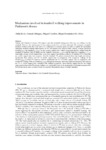Mostrar o rexistro simple do ítem
Mechanisms Involved in Treadmill Walking Improvements in Parkinson's Disease
| dc.contributor.author | Bello, Olalla | |
| dc.contributor.author | Márquez, Gonzalo | |
| dc.contributor.author | Camblor, Miguel | |
| dc.contributor.author | Fernández-del-Olmo, Miguel | |
| dc.date.accessioned | 2016-01-15T10:47:27Z | |
| dc.date.available | 2016-01-15T10:47:27Z | |
| dc.date.issued | 2010-05-10 | |
| dc.identifier.citation | Bello O, Márquez G, Camblor M, Fernández-del-Olmo M. Mechanisms involved in treadmill walking improvements in Parkinson's disease. Gait Posture;32(1):118-123 | es_ES |
| dc.identifier.uri | http://hdl.handle.net/2183/15866 | |
| dc.description.abstract | [Abstract] Patients with Parkinson's disease (PD) improve gait after treadmill training and while they are walking over the treadmill. However, the mechanisms of these improvements have not been addressed. We designed a treadmill simulator without a belt that could move on a walkway in a constant speed, in order to explore the mechanism underlying treadmill walking improvements in PD. All subjects were tested in three different sessions (treadmill, simulatorassisted and simulatornot assisted). In each session, subjects first walked overground and then walked using the treadmill or simulator with the hands over the handrails (simulatorassisted) or with the hands free (simulatornot assisted). Step length, cadence, double support time, swing time, support time and the coefficient of variation (CV) of step time and double support time were recorded. Over the treadmill PD patients increased their step length and reduced significantly their cadence and CV of double support time in comparison with overground walking. In the simulatorassisted condition PD patients reduced significantly the CV of double support time in comparison with overground walking. With the simulatornot assisted both groups decreased their step length and increased their cadence and CV of double support time, compared with walking overground. These findings suggest that the step length improvement observed in PD patients, walking over a treadmill, is due to the proprioceptive information generated by the belt movement, since no improvement was reported when patients using a treadmill simulator. | es_ES |
| dc.description.sponsorship | Ministerio de Ciencia e Innovación; PSI2008-03175 | es_ES |
| dc.description.sponsorship | Xunta de Galicia; 2009/002 | es_ES |
| dc.language.iso | eng | es_ES |
| dc.publisher | Elsevier | es_ES |
| dc.relation.uri | http://dx.doi.org/10.1016/j.gaitpost.2010.04.015 | es_ES |
| dc.rights | Creative Commons Licence | es_ES |
| dc.rights | Reconocimiento-NoComercial-SinObraDerivada 4.0 Internacional | |
| dc.rights.uri | http://creativecommons.org/licenses/by-nc-nd/4.0/ | |
| dc.subject | Parkinson's disease | es_ES |
| dc.subject | Rehabilitation | es_ES |
| dc.subject | Gait | es_ES |
| dc.subject | Treadmill | es_ES |
| dc.subject | Physical therapy | es_ES |
| dc.title | Mechanisms Involved in Treadmill Walking Improvements in Parkinson's Disease | es_ES |
| dc.type | info:eu-repo/semantics/article | es_ES |
| dc.rights.access | info:eu-repo/semantics/openAccess | es_ES |
Ficheiros no ítem
Este ítem aparece na(s) seguinte(s) colección(s)
-
II - Artigos [692]






